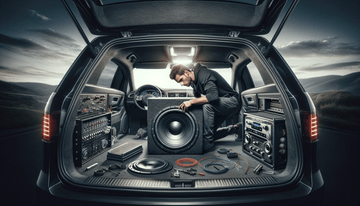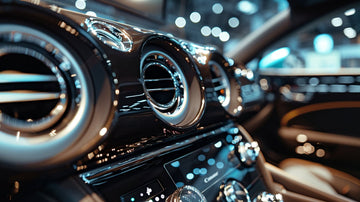The Complete Car Audio Installation Manual
Professional-Level Step-by-Step Installation Guide
Expert Installation Resource - This manual contains professional-grade installation procedures. Always prioritize safety and consult professionals for complex installations.
Complete Installation Manual Contents
Safety & Preparation
- • Essential Safety Protocols
- • Professional Tool Requirements
- • Pre-Installation Vehicle Assessment
- • Workspace Setup
Head Unit Installation
- • Single DIN vs Double DIN
- • Factory Integration
- • Steering Wheel Control Retention
- • Backup Camera Integration
Speaker Systems
- • Door Speaker Installation
- • Component System Setup
- • Tweeter Mounting
- • Crossover Installation
Amplifier Installation
- • Power Wire Routing
- • Grounding Procedures
- • Signal Wire Installation
- • Gain Setting & Tuning
Subwoofer Systems
- • Enclosure Installation
- • Wiring Configurations
- • Phase & Polarity
- • System Integration
Advanced Systems
- • DSP Installation & Setup
- • Multi-Amp Configurations
- • System Tuning
- • Professional Troubleshooting
Essential Safety Protocols
CRITICAL SAFETY WARNINGS
- • Always disconnect negative battery terminal first - Wait 10+ minutes for airbag systems to discharge
- • Never work on airbag-equipped vehicles without proper procedures - Risk of deployment and injury
- • Use proper eye protection - Metal filings and debris are common during installation
- • Fuse all power connections within 6 inches of battery - Use proper ANL or MIDI fuses
- • Never bypass factory safety systems - Retain all OEM functionality when possible
Pre-Installation Safety Checklist
Personal Protective Equipment
Professional Tool Requirements
Essential Hand Tools
Power Tools & Equipment
Specialized Audio Tools
Professional Tool Recommendations
Quality tools are essential for professional results. Invest in good wire strippers, crimpers, and a reliable multimeter. Cheap tools often damage wires and create poor connections that cause system failures.
Head Unit Installation Guide
Warning: Modern vehicles often have integrated systems. Removing the factory head unit may disable other vehicle functions. Research your specific vehicle before proceeding.
Step 1: Pre-Installation Assessment
Vehicle Compatibility Check
Required Components
- • Wiring Harness: Vehicle-specific (Metra/PAC/etc.)
- • Dash Kit: Matches vehicle interior
- • Antenna Adapter: Factory to aftermarket
- • Steering Wheel Interface: If equipped
- • Backup Camera Retention: If equipped
Step 2: Factory Head Unit Removal
Common Removal Methods by Vehicle Type
Honda/Acura (2006-2015)
- Remove hazard switch panel
- Remove climate control knobs
- Remove 4 screws behind climate panel
- Pull radio forward, disconnect harnesses
Ford (2013-2020)
- Use plastic trim tools on edges
- Pull trim panel forward carefully
- Remove 4 Torx screws (T20)
- Slide unit out, disconnect connectors
Toyota/Lexus (2010-2018)
- Remove A/C vent tabs with trim tools
- Unclip center console trim panel
- Remove 4 Phillips screws
- Carefully extract unit and harnesses
GM (2014-2019)
- Remove instrument panel trim
- Use trim tools on radio bezel
- Remove mounting screws (varies)
- Pull unit forward, disconnect
Step 3: Wiring Harness Connection
Standard ISO Wire Color Codes
Power Connections
- • Red Wire (12V+): Constant power (battery)
- • Yellow Wire (ACC): Accessory power (ignition)
- • Black Wire (GND): Ground connection
- • Blue Wire (ANT): Antenna power control
- • Blue/White Wire: Remote amplifier turn-on
Speaker Connections
- • White/White-Black: Front Left (+/-)
- • Gray/Gray-Black: Front Right (+/-)
- • Green/Green-Black: Rear Left (+/-)
- • Purple/Purple-Black: Rear Right (+/-)
Professional Wiring Tips
- • Always use proper crimp connectors - never twist and tape
- • Solder connections for permanent installations
- • Use heat shrink tubing on all connections
- • Test all connections with multimeter before final assembly
- • Label all custom wires for future service
Step 4: Integration Modules
Steering Wheel Control Interface
Common modules: PAC SWI-RC, Metra ASWC-1
- Connect SWC harness to vehicle's steering wheel wires
- Program interface for specific vehicle (refer to manual)
- Connect output to head unit's SWC input
- Test all steering wheel functions
- Fine-tune button mapping if needed
Factory Amplifier Integration
Required for Bose, JBL, Premium systems
- Identify factory amp location and connector
- Install line output converter (LOC) if needed
- Connect LOC to factory amp inputs
- Route RCA outputs to new head unit
- Retain factory amp turn-on signal
Speaker Installation Guide
Door Speaker Installation
Critical: Improper door panel removal can damage clips and electrical connections. Research your specific vehicle's procedure thoroughly.
Pre-Installation Speaker Assessment
Common Speaker Sizes by Location
- • Front Doors: 6.5", 6×9", 6.75"
- • Rear Doors: 6.5", 5.25", 6×9"
- • Dash: 3.5", 4", tweeter locations
- • Rear Deck: 6×9", 6.5" (sedans)
- • A-Pillar: Tweeter mounts (component systems)
Step-by-Step Door Panel Removal
Universal Door Panel Removal Process
Step 1: Hardware Removal
- Remove door handle trim pieces
- Remove window/mirror control switches
- Remove armrest screws (usually hidden under covers)
- Remove door pull handle fasteners
- Check for hidden screws in pockets/storage areas
Step 2: Clip Locations
- Bottom edge: 3-4 clips typically
- Sides: 2-3 clips per side
- Top edge: Window weatherstrip retention
- Corner clips: Often the strongest
Step 3: Panel Separation
- Start at bottom corner with trim tool
- Work along bottom edge, releasing clips
- Move up sides, supporting panel weight
- Lift panel up and out (window track clearance)
- Disconnect electrical connections carefully
Step 4: Water Barrier
- Carefully peel back plastic sheeting
- Avoid tearing - reuse if possible
- Access speaker through existing opening
- Enlarge opening if necessary
Speaker Wiring and Installation
Speaker Wire Specifications
Wire Gauge by Power Level
- • 0-50W RMS: 18 AWG minimum
- • 50-100W RMS: 16 AWG recommended
- • 100-200W RMS: 14 AWG required
- • 200W+ RMS: 12 AWG or larger
Wire Length vs Gauge
- • Under 10 feet: Add one gauge size
- • 10-20 feet: Add two gauge sizes
- • Over 20 feet: Calculate voltage drop
- • High-power runs: Consider 12 AWG minimum
Proper Speaker Wiring Technique
- Polarity Check: Positive terminal to positive wire (usually marked or colored)
- Connection Method: Use spade connectors, banana plugs, or quality crimp terminals
- Wire Routing: Avoid pinch points and moving parts in door mechanisms
- Strain Relief: Loop wire to prevent stress on connections
- Weather Protection: Use dielectric grease on exposed connections
Component System Installation
- Woofer Mounting: Standard door location with proper depth clearance
- Tweeter Placement: A-pillar, sail panel, or dash (aim at listener)
- Crossover Location: Behind door panel, under seat, or trunk (keep dry)
- Wiring Harness: Run separate cables to woofer and tweeter
- Phase Alignment: Ensure all drivers are in-phase
Tweeter Installation Locations
A-Pillar Mount
Best For: Optimal imaging and staging
- Requires custom fabrication
- Excellent stereo imaging
- May require airbag consideration
- Professional installation recommended
Sail Panel
Best For: Factory-like appearance
- Often has factory tweeter location
- Easy wire routing
- Good imaging when angled properly
- Minimal modification required
Dashboard
Best For: Quick installation
- Surface mount options available
- May compromise imaging
- Easy to adjust angle
- Temporary installation friendly
Amplifier Installation Guide
DANGER: Improper amplifier installation can cause vehicle fires, electrical damage, or personal injury. All power connections must be properly fused within 6 inches of the battery terminal.
Step 1: Power Wire Installation
Power Wire Gauge Chart
| Amplifier Power | Wire Gauge | Fuse Rating |
|---|---|---|
| Up to 500W | 8 AWG | 40-50A |
| 500-1000W | 4 AWG | 80-100A |
| 1000-1500W | 2 AWG | 125-150A |
| 1500-2500W | 1/0 AWG | 175-200A |
| 2500W+ | 2/0 AWG+ | 250A+ |
Power Wire Routing Path
- Battery Connection: Positive terminal with proper fuse holder
- Firewall Entry: Use existing grommet or create new sealed entry
- Interior Routing: Along door sills under carpet/trim
- Amplifier Location: Secure mounting with proper ventilation
- Avoid: Heat sources, moving parts, sharp edges
Step 2: Proper Grounding Procedures
Professional Grounding Checklist
Ground Wire Requirements
- • Same gauge as power wire (minimum)
- • Shortest possible run to chassis
- • High-quality ground terminal/lug
- • Marine-grade tinned copper wire
Ground Point Preparation
- • Remove paint/coating to bare metal
- • Use star washer for metal contact
- • Apply dielectric grease after connection
- • Verify with ohmmeter (less than 0.1Ω)
Acceptable Ground Points
- ✅ Body bolt to frame: Excellent conductivity
- ✅ Seat mounting bolt: Usually good chassis connection
- ✅ Metal bracket: Verify solid chassis attachment
- ✅ Factory ground point: Already proven connection
- ⚠️ Custom drilled point: Verify no wiring/fuel lines behind
Avoid These Ground Points
- ❌ Painted surfaces: Poor conductivity
- ❌ Plastic components: No electrical connection
- ❌ Moving parts: Connections will fail
- ❌ Thin sheet metal: May tear or bend
- ❌ Near fuel system: Safety hazard
Step 3: Signal Wire Installation
RCA Signal Wire Routing
Proper Routing Technique
- Route opposite side of vehicle from power wire
- Use factory wire looms when possible
- Secure every 12-18 inches with zip ties
- Avoid sharp edges and pinch points
- Leave service loops at both ends
Signal Wire Quality
- Use shielded RCA cables
- Quality matters - avoid bargain cables
- Proper length - no excess coiling
- Gold-plated connectors preferred
- Consider balanced XLR for long runs
Step 4: Amplifier Mounting and Ventilation
Trunk Mounting
Most Common Location
- Side panel mounting brackets
- Ensure 6+ inches clearance around amp
- Avoid blocking spare tire access
- Consider security (visible/theft)
Under-Seat Mounting
Compact Amplifiers Only
- Check seat clearance when moving
- Minimal ventilation available
- Good security (hidden)
- Easy wire routing
Custom Enclosure
Professional Installation
- Maximizes space efficiency
- Optimal ventilation design
- Integrated with vehicle interior
- Higher installation cost
Step 5: Gain Setting and Initial Tuning
Warning: Improper gain setting is the #1 cause of speaker damage. Start with gains at minimum and increase gradually while monitoring for distortion.
Professional Gain Setting Procedure
- Equipment Setup: Use oscilloscope or distortion detector
- Head Unit Volume: Set to 75% of maximum clean output
- Input Sensitivity: Start with gain at minimum position
- Test Signal: Play 1kHz sine wave or pink noise
- Gain Adjustment: Increase until distortion detected
- Back Off: Reduce gain 10-15% from distortion point
- Repeat: For each channel/frequency band
Basic Tuning Without Instruments
- Conservative Start: All gains at 25% position
- Volume Reference: Normal listening level on head unit
- Listen for Distortion: Gradually increase gains
- Stop at First Distortion: Back off immediately
- Play Variety: Test different music types
- Final Check: Maximum head unit volume test
- Document Settings: Record all gain positions
Subwoofer System Installation
Enclosure Installation and Placement
Sealed Enclosure
Best For: Tight, accurate bass
- Volume: 0.5-1.5 cubic feet typical
- Sound: Controlled, musical bass
- Power: Requires more amplifier power
- Space: More compact design
Ported Enclosure
Best For: Maximum output
- Volume: 1.5-3.0 cubic feet typical
- Sound: Louder, more impactful
- Power: More efficient, less power needed
- Space: Larger enclosure required
Bandpass Enclosure
Best For: SPL competition
- Volume: Variable, complex design
- Sound: Very loud in narrow range
- Power: Extremely efficient
- Space: Largest enclosure type
Subwoofer Wiring Configurations
Impedance and Wiring Calculator
Dual Voice Coil (DVC) Subwoofer
Each subwoofer has two voice coils
- • DVC 4Ω: Can wire to 2Ω or 8Ω
- • DVC 2Ω: Can wire to 1Ω or 4Ω
- • Series: Coils in series = higher impedance
- • Parallel: Coils in parallel = lower impedance
Multiple Subwoofer Wiring
Combining multiple subs changes total impedance
- • Series: Impedances add together
- • Parallel: Total impedance decreases
- • Series/Parallel: Complex combinations
- • Match Amp: Ensure amp can handle final load
Common Wiring Examples
Single DVC 4Ω Subwoofer
- Parallel Connection: 2Ω load to amplifier
- Series Connection: 8Ω load to amplifier
- Wire Colors: Positive (red), Negative (black)
- Best For: Most 2/4 ohm stable amplifiers
Two DVC 4Ω Subwoofers
- Each Sub Series, Subs Parallel: 4Ω final load
- Each Sub Parallel, Subs Series: 4Ω final load
- All Parallel: 1Ω final load (mono-stable amp required)
- All Series: 16Ω final load (rarely used)
Single DVC 2Ω Subwoofer
- Parallel Connection: 1Ω load to amplifier
- Series Connection: 4Ω load to amplifier
- Amplifier Requirements: Must be 1Ω stable for parallel
- Power Considerations: More power at lower impedance
Power Wire Gauge for Subwoofers
- 500W RMS: 8 AWG minimum
- 1000W RMS: 4 AWG recommended
- 1500W RMS: 2 AWG required
- 2000W+ RMS: 1/0 AWG or larger
Phase and Polarity Setup
Critical: Incorrect phase/polarity will cause bass cancellation and poor system integration. Always verify proper connection before final installation.
Polarity Verification Process
- Visual Check: Positive terminals to positive wires (red)
- Battery Test: Touch 9V battery to subwoofer terminals
- Cone Movement: Positive connection should move cone outward
- Mark Polarity: Label positive terminals clearly
- System Test: Play bass-heavy music and listen for fullness
- Phase Switch: Try 0° and 180° settings on amplifier
- Integration Test: Ensure subwoofer complements main speakers
Common Phase Issues and Solutions
Problem: No bass output
Solution: Check polarity - likely reversed connection
Problem: Weak bass output
Solution: Try 180° phase switch on amplifier
Problem: Bass sounds disconnected
Solution: Adjust crossover frequency and slope
DSP Installation and Setup
Advanced Installation: DSP installation requires technical knowledge of audio processing and measurement equipment. Consider professional installation for optimal results.
DSP System Integration
Integration Methods
High-Level Input (Speaker-Level)
- Connect to existing speaker wires
- Best for factory amplified systems
- Retains factory features
- May require load resistors
Low-Level Input (RCA)
- Direct connection from head unit
- Cleanest signal path
- Requires preamp outputs
- Best overall sound quality
DSP Placement Considerations
- • Location: Hidden but accessible for service
- • Ventilation: Adequate airflow for heat dissipation
- • Mounting: Secure to prevent vibration damage
- • Wiring Access: Space for input/output connections
- • Remote Control: Consider knob placement for user access
- • Software Access: USB/Bluetooth connection accessibility
Basic DSP Configuration
Initial Setup Sequence
1. Input Configuration
- Set input sensitivity to match source
- Configure input channels (stereo/mono)
- Set input delay compensation
- Calibrate input levels
2. Output Configuration
- Assign outputs to speakers
- Set high-pass filters
- Set low-pass filters
- Configure crossover slopes
3. Time Alignment
- Measure distances to each speaker
- Set delays for proper staging
- Fine-tune with listening tests
- Account for driver acoustical centers
4. Equalization
- Start with flat response
- Make broad corrections first
- Address major peaks/nulls
- Fine-tune with RTA measurements
Important: DSP tuning is an advanced skill that requires measurement equipment and acoustic knowledge. Start with manufacturer presets and make gradual adjustments while learning.
Professional Troubleshooting Guide
Common Installation Problems
No Power Issues
Symptom: Head unit won't turn on
- Check fuses (head unit and vehicle)
- Verify constant 12V on red wire
- Check ground connection resistance
- Test accessory wire (yellow) for 12V with ignition on
Symptom: Amplifier protection light on
- Check for short circuits in speaker wires
- Verify proper ground connection (less than 0.1Ω)
- Ensure adequate ventilation around amplifier
- Check for proper impedance load
Audio Quality Issues
Symptom: Noise/static in audio
- Separate power and signal cables
- Check for loose RCA connections
- Verify proper grounding of all components
- Use quality shielded cables
Symptom: Distorted sound at volume
- Reduce amplifier gain settings
- Check speaker impedance matching
- Verify adequate power supply
- Test with different source material
Diagnostic Procedures
Systematic Troubleshooting Approach
1. Visual Inspection
- Check all connections for tightness
- Look for damaged wires or cables
- Verify fuse conditions
- Inspect for signs of overheating
2. Electrical Testing
- Measure voltages with multimeter
- Check continuity of all connections
- Test ground resistance (should be <0.1Ω)
- Verify impedance loads are correct
3. Isolation Testing
- Test components individually
- Substitute known good components
- Check system in sections
- Use process of elimination
4. Performance Verification
- Test at various volume levels
- Check frequency response
- Verify all features function
- Document final settings
When to Seek Professional Help
DIY Appropriate
- Basic speaker replacement
- Simple amplifier installation
- Head unit upgrades
- Basic troubleshooting
- Wire routing and connections
Consider Professional
- Factory integration systems
- Complex DSP setup
- Custom fabrication work
- Multiple amplifier systems
- Competition-level installations
Require Professional
- Airbag system modifications
- Advanced factory integration
- Electrical system diagnosis
- Warranty-affecting modifications
- Safety system integration
Final System Testing and Verification
Quality Assurance: Proper testing ensures long-term reliability and optimal performance. Don't skip this crucial step.
Complete System Checkout
Functional Testing Checklist
Performance Verification
Documentation and Warranty
Installation Documentation
Record All Settings
- Amplifier gain positions
- Crossover frequency settings
- DSP configuration backup
- Head unit presets and settings
- Wire routing documentation
Warranty Information
- Save all component receipts
- Register products with manufacturers
- Document installation date
- Keep wiring diagrams for service
- Note any custom modifications
Break-In Period Recommendations
New audio components benefit from a break-in period for optimal performance:
- Speakers: Play varied music at moderate volume for 20-40 hours
- Subwoofers: Gradually increase power over first 10-20 hours
- Amplifiers: Allow thermal cycling during initial use
- System Integration: Fine-tune settings after components settle
Professional Installation Complete
Your car audio system is now professionally installed and optimized for maximum performance.
Installation Success - Your audio system has been installed following professional standards and best practices. Enjoy your enhanced listening experience!




